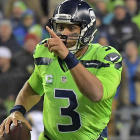Things have a way of sneaking up on you in the NFL. Everything is cyclical – a league of nonstop ups and downs the result of a salary cap and draft and scheduling process that prizes parity over all – and it doesn't take long before coaches and general managers are forced to juggle their rosters and alter their course.
Seems not that long ago when the Seattle Seahawks were seeking ways to extend their reign atop the NFC West as perennial Super Bowl contenders, trading for Jimmy Graham and extending players like Earl Thomas, Michael Bennett, Kam Chancellor, Bobby Wagner and Doug Baldwin and, most importantly, striking a record deal at the time to usher Russell Wilson off his rookie contract and into the pantheon of the game's higher-paid players.
Alas, much has changed since then, with Bennett traded away and Thomas available via trade (albeit at a steep price) and Chancellor and Cliff Avril likely headed to injury-related retirement and Richard Sherman released and Graham, Sheldon Richardson and Paul Richardson all departed as free agents. The Seahawks – bold, brash and defensively dominant as we long knew them – are no more, and no franchise in the league is grappling with quite this much seismic change over the past few weeks (although I'd point out the Patriots, the NFL's lone team seemingly immune to the perils of parity, are in a similar predicament naturally born of winning, aging and difficulties tied to keeping a roster together).
Suddenly, the Seahawks are retooling and re-assessing their asset allocation and, somehow, Wilson is quietly in line for a new contract sooner rather than later amid all of this transition and change. Yes, believe it or not, he is in a very similar position as Aaron Rodgers and Matt Ryan – with just two years left on a contract that no longer reflects the NFL where Mike Glennon and Brock Osweiler got $19M for a year to pretend to be starting quarterbacks, and where Case Keenum gets $36M for two years and Kirk Cousins gets $84M fully guaranteed for three years.
Somehow, in the span of just a few short years, Wilson's record four-year deal at the time is now a quaint throwback, a relic to a bygone time when the perennial Pro Bowler went from being the biggest bargain in the league and barely a millionaire to securing a legit quarterback contract. Yes, it's been without the national fanfare that is accompanying all of the hand-wringing and speculation about what Rodgers and Ryan will end up getting on their extensions, and it hasn't been a topic of open discussion like it has with Rodgers and Ryan, but Wilson is very much in the same position.
Ryan has one year remaining on his deal, set to make $19.25M in 2018, and the Falcons have been talking about his next contract as a fait accompli of sorts – certainly their top offseason priority – as one would expect. Rodgers has two years left on his contract – at $20.6M this season and $21.1M in 2019 – and it would be a surprise to many executives around the league if Rodgers doesn't get a multi-year extension before Week 1, given the rate of escalation of quarterback contracts and Rodgers' standing as the best in the world when healthy (certainly the best quarterback in the NFL under age 40, with Tom Brady the ultimate outlier).
So what does that mean for Wilson and the Seahawks?
Well, there has been decidedly less chatter about any deal for Wilson. In fact, I'm told the topic has not been discussed between the sides. Neither has made it a priority or a point to begin the dialogue with the other and there are no signs of any momentum toward that outcome. It hasn't been broached and there's no reason to anticipate it comes up anytime soon. That could obviously change within the next six to 18 months, but from afar this still seems like some sort of feeling-out process is going on, that maybe both parties are still sizing each other up, perhaps, and trying to determine what the future holds.
Certainly, Wilson has to be doing some internal calculus about the state of the roster around him, about watching Sherman walk after suffering a significant injury and doing nothing but win to this point in his pro career. Given how often he is running for his life on Sundays, and given his stated desire to play football for as long as Brady has, could Wilson now be contemplating his football mortality with the offensive line still a significant concern? It would only be human. The addition of DJ Fluker offers some help for a unit in significant need of it, but will the Seahawks seek to extend veteran left tackle Duane Brown and will their recent draft picks develop into stable linemen?
As it stands today, after the first wave of free agency that eliminated most of the few impact players available in this tepid unrestricted class of players, the Seahawks would have Nick Vannett and Ed Dickson as their top tight ends, they would deploy Tyler Lockett and Marcus Johnson (acquired in the Bennett trade) to compliment Baldwin at receiver (free agent Terrelle Pryor remains on their radar), and would be hoping that Chris Carson, C.J. Prosise, Thomas Rawls or other holdovers could be healthy and productive at running back. That's not an overwhelming supporting cast, to say the least.
I'm not sure this is what Pete Carroll had in mind when he spoke of challenging Wilson more this year in the aftermath of an overhaul of the coaching staff and some scheme on offense, but no doubt this current group of Seahawks would require Wilson to be even more transformational than usual if they are to contend as they have for the past half-dozen years. Of course, wasting millions on mediocre players – which will be the endgame of this 2018 free-agent splurge for many teams – and overpaying marginal receivers probably isn't the best way to try to solve these rosters issues, either, but that's the predicament.
Again, we are still a half year from playing games that count, so there is no need to panic. And it's only natural that a team with this much success has to take a step or two back in order to get back on top. And Seattle GM John Schneider is one of the more proactive, free-thinking, bold executives in the game, willing to fully explore the trade market. He can still reshape this roster, particularly if Thomas is dealt before the draft, but it also stands to reason that the 2018 Seahawks will not be overloaded with blue-chip skill players on offense, and questions remain about their ability to protect the quarterback.
In the next year we'll learn a lot more about the direction of this team, how quickly they can get back on track, how heathy Wilson emerges from the 2018 season, how confident he can be in the group of men entrusted to block for him. Will the Seahawks be talking about a five-year deal worth $30M a year for Wilson come this time a year from now? If not, will there be trade rumblings? (Given the supply/demand problems in the quarterback market, a hypothetical Wilson trade would have to be the blockbuster to end all blockbusters, right?) Is Carroll, the oldest coach in the NFC, inching closer to retirement by then if this team is outside the playoffs again?
Personally, I have a hard time seeing a generational talent at quarterback like this leaving the team that originally drafted him in his prime, and Schneider has displayed the ability in the past to kickstart a rebuild with a single draft. I wouldn't bet on him being down for long, but with the draft just over a month away and spring finally upon us, the Seahawks can't be considered among the handful of Lombardi favorites for the first time in a long time, and much work remains to be done to return to the lofty perch their fans have come to expect during the Carroll/Schneider era.
















